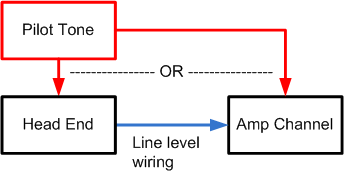Speaker Tone Sensing (STS) allows monitoring of the system from the input of the pilot tone to the amplifier outputs. The pilot tone is the stimulus that is continuously measured at the output of the amplifier and is defined as the system steady state level. If the pilot tone is not detected at the amplifier output, an alert is issued.
The pilot tone is input into the system at or before the amplifier input and is typically placed at or near 20KHz to be out of the audible range. The pilot tone level is kept relatively low but must be detected by the remote output VU meters. A typical level as measured at the amplifier output is around 1.5V RMS. The Impedance of most speakers at the upper end of the audio spectrum is very high. Therefore, not much power is dissipated.
Software monitors the output VU meter for the presence of the pilot tone. The STS software has entry for a threshold level (with hysteresis) for the output VU meter for each amplifier channel. If the output VU level falls below this threshold, a STS alert is issued.

STS continuously verifies the system from the entry point of the pilot tone to the amplifier output.
|
See also |